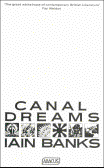
Publisher: Abacus (1990 reprint, orginally published 1989 by MacMillan London Limited)
ISBN: 0 34910 171 X
Précis: Trapped in the Panama canal in the midst of a bloody civil war, three ships lie at anchor. Their skeleton crews wait out the deceptively calm days, and at night hold parites lit by shell- fire for the passengers. One of those passengers is Hisako Onoda, world-famous cellist bound for Europe but afraid to fly. Diving from the tanker that has become her home, with the young French officer who has become her lover, Hisako first hears the drowned, whining noise of outboard engines, bringing the fury of the war to the ships and the people on them in a spiral of nightmare; a nightmare of a lake full of blood and a sky full of fire, which like the war itself, heralds only apocalypse.
Summary: Hisako Onoda, a renowned Japanese Cellist, is (as the Précis says) trapped in the middle of the Panama canal as the war rages on around her. Having been taught to dive by her lover, Philippe, she and he while away the days and nights by going on dives. During the day the fellow passengers from the three ships trip into town and play games as they try to relieve the tedium. And so the days pass till finally, while Hisako is on a night time dive, boats arrive bringing guerilla troops who quickly take over the three boats.
Transfering all the passengers over to one ship a guard is mounted to keep an eye on them. By and large they are treated well if confined to one room. Hisako is then removed to another ship to give a private concerto to a stranger who remains careful to stay in the darkness and hard to see. After playing for him the generator fails and the lighting changes, revealing the stranger to be an american soldier. Hisako correctly reasons that he is here to shoot down the plane carrying congressmen due to fly over the canal tomorrow.
Transferred back to the ship holding the crew and passengers she whiles away the time sleeping. Unbeknown to the guerilla's one passenger, a rather gung-ho american, has not been captured and he tries to effect a rescue. Unfortunately he is out numbered and killed. His actions however have raised the tension levels dramatically till the decision is made to kill the passengers and crew.
Hisako is kept to one side and watches as the people she has come to know are gunned down, to the last one. Raped and abused Hisako is then locked down in an engineering space to reflect on watching the guerilla's machine gun her cello. Discovering that there is a sharp edge available to cut her bonds she cuts herself free in time to kill the guerilla who came in to check on her, and most likely abuse her again.
Methodically and quietly she stalks through the first ship, killing the largely sleeping guerillas onboard. Taking a gemini runabout, and crippling the other one, she begins to head towards the next ship - where the american is. Halfway there the alarm is raised when no-one can be contacted onboard the ship Hisako left. A brief fight between Hisako and the troops breaks out with Hisako killing the American but being forced to abandon her weapons and the runabout.
Eluding the searchers she eventually finds refuge aboard the oil tanker, setting the pumps to release a slick of oil onto the lake. Sleeping she awakens to the noise of the remaining guerillas, now confused with their leader missing, leaving the tanker. Finding a flare gun she sets the lake alight killing the last of the guerillas. Using the scuba diving gear she then swims underneath the flames to the lakes edge and safety.
Comments: Of all of Iain's work this one is perhaps the most pedestrian. It basically is a tale of revenge set aboard a ships trapped in the canal. Occasional flashes of style surface that raise the tenor of the novel well above the average for this type of tale but there isn't the general humour and panache that is featured in the other books.
While I enjoyed this book, it is not something I can really reccomend to any great degree. If you see it, then read it - the complexity of the tale itself and the general references to events and people is worth the reading. But given the calibre of Iain's other work this one is a bit of a disappointment.